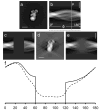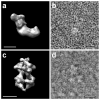Projection-based volume alignment
- PMID: 23410725
- PMCID: PMC4497410
- DOI: 10.1016/j.jsb.2013.01.011
Projection-based volume alignment
Abstract
When heterogeneous samples of macromolecular assemblies are being examined by 3D electron microscopy (3DEM), often multiple reconstructions are obtained. For example, subtomograms of individual particles can be acquired from tomography, or volumes of multiple 2D classes can be obtained by random conical tilt reconstruction. Of these, similar volumes can be averaged to achieve higher resolution. Volume alignment is an essential step before 3D classification and averaging. Here we present a projection-based volume alignment (PBVA) algorithm. We select a set of projections to represent the reference volume and align them to a second volume. Projection alignment is achieved by maximizing the cross-correlation function with respect to rotation and translation parameters. If data are missing, the cross-correlation functions are normalized accordingly. Accurate alignments are obtained by averaging and quadratic interpolation of the cross-correlation maximum. Comparisons of the computation time between PBVA and traditional 3D cross-correlation methods demonstrate that PBVA outperforms the traditional methods. Performance tests were carried out with different signal-to-noise ratios using modeled noise and with different percentages of missing data using a cryo-EM dataset. All tests show that the algorithm is robust and highly accurate. PBVA was applied to align the reconstructions of a subcomplex of the NADH: ubiquinone oxidoreductase (Complex I) from the yeast Yarrowia lipolytica, followed by classification and averaging.
Copyright © 2013 Elsevier Inc. All rights reserved.
Figures






References
-
- Crowther RA, DeRosier DJ, Klug A. The reconstruction of a three-dimensional structure from its projections and its applications to electron microscopy. Proc R Soc London. 1970;A317:319–340.
-
- Deans SR. The Radon Transform and some of Its Applications. John Wiley & Sons; New York: 1983.
Publication types
MeSH terms
Substances
Grants and funding
LinkOut - more resources
Full Text Sources
Other Literature Sources

